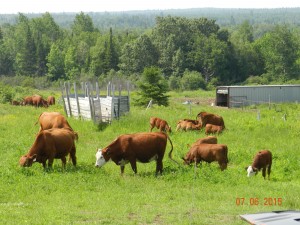 If you’re interested in building a cattle herd with a focus on long term profit and sustainability, you need to be culling cows. Without a disciplined culling strategy in place, under-performing cows will bleed profit out of an operation quick.
If you’re interested in building a cattle herd with a focus on long term profit and sustainability, you need to be culling cows. Without a disciplined culling strategy in place, under-performing cows will bleed profit out of an operation quick.
Not familiar with culling? It’s simply the practice of removing poorly performing animals from your herd. But even though the idea is simple, the specifics of why and how to cull cows can be complex, and varies from herd to herd and year to year in the cattle business.
How many animals you should cull each year depends on several factors. You see, there are a few basic flaws a cow has that guarantee she’ll be a cull, but beyond those few is a multitude of reasons that may or may not be justification for culling. It all depends on your situation. Let’s go over the basics.
Open Cows
A cow that isn’t pregnant should almost always be culled from your herd. This is the most basic culling decision, and it probably makes more sense than any other culling criteria. That’s because an open cow won’t give you a calf, and you’ll still have to feed and keep her until the next breeding season. A year of cow maintenance cost with no financial return is a no brainer. Even at rock bottom prices, you just have to send her down the road.
The only exception to culling open cows is the first-calf heifer. A heifer that is raising her first calf and still growing herself is under an incredible amount of pressure to perform and rebreeding rates for these animals can be dismally low. Because they are so young (with a lifetime of productivity ahead of them) and under such pressure to perform, many cattle operations give these first calvers a second chance. This may be a financially sound decision, but remember that fertility and maintenance demands are heavily tied to genetics, and by giving the girls a second chance you may be lowering the overall genetic quality of your herd.
Old Cows
Just like us, cows don’t live forever. The old ones begin to lose their teeth, eyesight and other crucial things. That’s why many cattlemen cull old cows. They don’t want to take the chance that they’ll have to keep a cow that just won’t get it done for one more year. Culling (or not culling) cows for age can be risky. When calf prices are high, it’s probably better to take the risk of keeping an old cow because if she performs, the sale of her calf in the fall is well worth it. In times of low calf prices, the reverse is true, and it’s probably wise to cull these older cows to make room for younger, more productive ones.
Ornery, Crazy, or Just Plain Difficult Cows
There are a number of ways a cow can make the cattle operation difficult. She can be the one that almost kills you each time you try to tag her calf. She can cause problems by trying to steal other cows’ calves (happened to us). She might be the one who lags behind during each herd move (we have one of those). She could have gotten mastitis (us again) and won’t produce enough milk to raise a rigorous calf (we decided to take a chance and keep that cow). She could learn to disrespect electric fence (our most recent struggle) and cause havoc in your winter hay bale grazing program.
When deciding to cull these cows with unique difficulties, you need to weigh the financial and emotional costs they incur against the potential money they’ll make you. Other factors such as how much available feed you have in store and the availability of good replacement cows need to be taken into account as well.
There’s no doubt that the art of properly culling cows is critical to the long term profitability of a cattle operation. How many you cull and how strict you are with your culling decisions depends completely on your situation and the economics of the industry at the time. So what’s a reasonable culling rate? A wise man once said that if about 10 percent of your herd is culled out each year, you’re probably headed toward long term genetic improvement, which should result in sustainability and economic success. But that’s a discussion for another day.
Leave a Reply